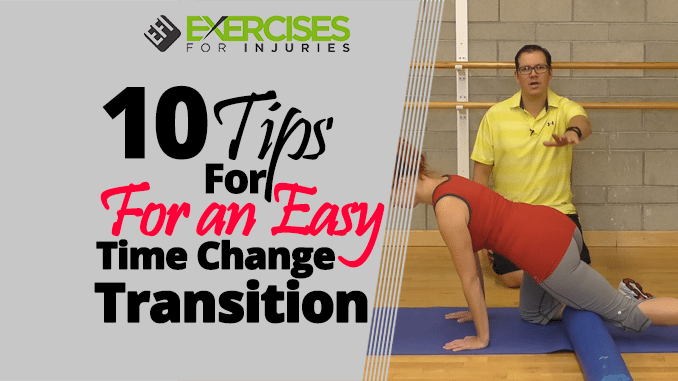
Hey, I hope you are having a great Monday.
This time of the year is always tough for me, my kids, and my dog, as adjusting to the clock change is difficult.
To help my dog adjust, I brought him to the dog park.
Today, I will share ten tips to make your time change transition easier.
It is time to “fall back” since winter is coming. These changes disrupt our sleep and energy cycles. To ease your transition to the time change, follow some tips for an easy time change.
Our body runs on an internal clock that affects our sleep cycles and energy levels. Twice a year, we disrupt our biological rhythms when switching between Daylight Savings Time and Standard periods.
How Time Changes Affect Us
Circadian rhythms control our internal body clocks, including our sleep and waking cycles. The common theory is that our circadian rhythm correlates to the sun’s cycle.
The transition to Daylight Savings Time each spring disconnects this natural rhythm. Our annual change to Standard Time also disrupts our body clocks and circadian rhythm.
Disruptions to our circadian rhythm cause insomnia, loss of energy, loss of appetite, and hormone imbalances. Some people experience an increase in headaches and depression after a time change Studies indicate that traffic accidents also increase as we transition to Standard Time.
Time change is part of our lives. However, we can calibrate our internal body clocks. These ten tips help ensure an easier transition from Daylight Savings Time to Standard Time.
The time change disrupts delicate circadian rhythms. The result is similar to how jet lag causes sleepless nights. These tips negate some of the negative effects of the transition to Standard Time.
10 Tips for an Easy Time Change Transition
1. Adjust Your Sleep Pattern Gradually
Anticipate the change and slowly adjust your sleep and wake schedule accordingly. While the change is only one hour, many people have trouble sleeping on both ends of the time change.
2. Be Aware of Increased Risk of Traffic Accidents
During the winter, the nights get longer and the days shorter. This natural change feels more abrupt during the transition between Daylight Savings to Standard time. It is suddenly darker driving to and from work. According to the University of Newcastle, this decreased visibility also increases traffic accidents. Be extra careful when driving and extra budget time for a safe commute.
3. Harness the Mood-boosting Effects of Exercise
During November, many people experience seasonal depression. Daily exercise boosts moods and helps our internal body clocks adjust to the new seasons and time changes. Any moderate to vigorous activity helps, but exercise outside is especially effective.
If you usually exercise before or after work, be aware of decreased visibility. As mentioned, the autumn time transition leads to an increase in accidents. Whether you run or cycle, wear light and dress for visibility Pedestrians should also wear light-colored and reflective clothing. Also, exercise with a friend whenever possible and stick to well-lit paths.
4. Spend Time Outside During the Day
Our natural circadian rhythms connect with the natural cycle of daylight and nightfall. Whether combating jet lag or our annual time zone, time spent outside helps recalibrate our internal body clock.
If possible, spend time during your lunch break outside. You may find it dark when you leave for work in the morning and return home. For maximum results, take a brisk walk outside during your lunch break, as exercise also helps regulate our energy, mood, and body rhythms.
5. Consider Using a Daylight Box
People who work outside or in offices with windows have an advantage Our circadian rhythms coordinate with the sun’s cycle. Some people who work full-time in a windowless cubicle may suffer the most Some experience seasonal affective disorder (SAD) as the seasons change. While this is primarily related to lack of sunlight, the time transition may exacerbate this phenomenon. Many SAD sufferers find relief from a lightbox that simulates daylight.
6. Avoid Caffeine & Stimulants During Evening Hours
Limit consumption of coffee, tea, energy drinks, supplements containing stimulants, and chocolate during the evening hours. Depending on your sensitivity to caffeine, you may want to avoid caffeine starting at least 2 to 4 hours before your intended bedtime. Hidden caffeine and stimulants are especially troublesome.
7. Use Supplements Wisely
Some people feel they benefit from taking a melatonin supplement during the time change. Some recommend .3 milligrams daily. Some supplements are contraindicated with other supplements, medications, or health conditions. Discuss this or any supplements you are considering with your doctor.
8. Make Nutritional Adjustments
Our diet also drives our energy levels. Time changes sometimes alter appetite. Be sure to stick to a normal eating schedule and a balanced diet Foods containing sugars and processed simple carbohydrates tend to spike energy levels and cause a crash in energy. Be strategic in your carb consumption by keeping sugars and processed carbs to a minimum for an easier seasonal transition.
Healthy nutrition, exercise, and other positive choices help recalibrate our body clocks for a good night’s rest and healthy winter.
9. Expect Disturbance and Plan Accordingly
As much as possible, keep your schedule light for the next few days after the time change Lack of sleep may affect your concentration and your ability to focus A lighter schedule allows your brain to rest during the transition. The good news is the autumn transition is usually easier on sleep cycles since you potentially gain one extra hour of sleep on the night of the change.
10. Double Check the Time for a Frustration-free Day
Most devices adjust the time automatically but are sure that you reset all of your watches or clocks. While this tip doesn’t assist your circadian rhythms, it does affect your stress levels.
We all know” that person” who arrives too early or late the day after a time change. Confirm any appointments that day and confirm the person you are meeting is aware of the time change. A frustration-free day paves the way for a smooth adjustment.
Bonus Tip: Plan Something Relaxing or Uplifting
Never underestimate the power of your mind. For a mood and energy boost, plan an uplifting or relaxing activity. Are you feeling stressed? Why not schedule a massage? Are you feeling a little down? Make plans for a night out with friends or family.
Transitioning from Daylight Savings Time to Standard Time alters our body clocks. Our internal body clock balances our hormones, sleep cycle, moods, and health. Careful planning and a few adjustments allow for a healthy and energetic transition.
If you want to discover what foods will help you increase the natural healing power of your body and decrease your risk of degenerative diseases, then click here to check out the Best Foods That Rapidly Slim & Heal In 7 Days program!
Rick Kaselj, MS





